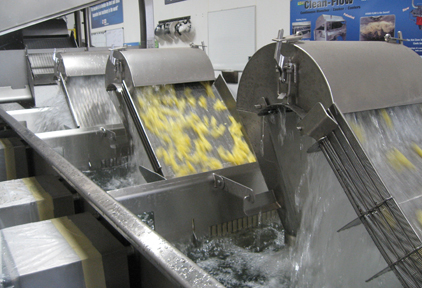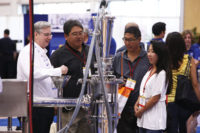
|
| Pasta run with the Easy-Flow™ multi-stage quench system saves energy in both heating and cooling and reduces the amount of water neeeded. Source: Lyco Manufacturing, Inc. |
In rotary drum cooking and cooling, pasta, rice or vegetables come out of the cooker typically at 200°F-205°F. The product then immediately goes into a cooler where it is cooled in 35°F-40°F chilled water. Initially, the water put into the cooler is tap water with a temperature of about 55°F -65°F. To bring the cooler’s water temperature down to the 35°F-40°F range needed for cooling product, energy is used to chill the water, according to Randy Unterseher, VP of marketing, Lyco Manufacturing, Inc.
As hot food products are introduced into the cooler, the chilled water absorbs heat removed from the product; the intent is to bring the product temperature down to a safe 40°F range quickly, to reduce the potential for bacterial growth.
Bacteria predominantly grow in an environment between 40°F and 140°F. During the cooking process, raw ingredients are brought up past 140°F as quickly as possible to the final cooking temperature, thus minimizing the time food products can be affected by bacterial growth. After cooking, reducing product temperature as quickly as possible to below 40°F is just as important.
Instead of moving the product directly from the 200°F-205°F water temperature of the cooker and into the 35°F-40°F cooler water, a mid-process quench cycle with unheated ambient-temperature tap water (55°F-65°F) can capture much of the product’s heat before it enters the primary cool zone.
“Quenching will reduce the temperature of the pasta, rice or vegetables down to 110°F-120°F, absorbing 45 to 50 percent of the cooked product’s heat energy in the quench water,” says Unterseher. “The 110°F-120°F water in the quench can then be used in the cooker for makeup water, instead of bringing in the usual 55°F-65°F tap water to reach the 200°F to 205°F temperature cooking range. This sizably reduces the energy draw normally needed to heat the cooker water.”
The quench step then releases the product into the cooler, which now only has to bring the product temperature down 70°F-80°F to reach the targeted 40°F, instead of needing to bring the temperature down 160°F-165°F if the quench cycle were not in place. The energy savings in the cooler from the reduced refrigeration load is significant, adds Unterseher.
The quench system developed by Lyco Manufacturing maintains 100 percent uniform product cooling, according to Unterseher.
“When recapturing heat from the cooling process, heating costs can be reduced by 72 percent, and water usage can be reduced by 25 percent,” says Unterseher. Cooling energy can be reduced by 41 percent, he adds.
For more information: Randy Unterseher, Lyco Manufacturing, Inc., 920-623-4152, randy.unterseher@lycomfg.com.




